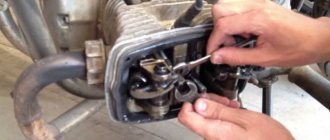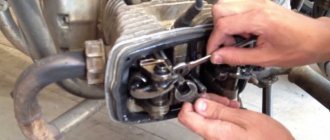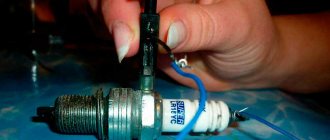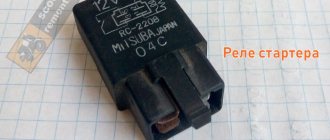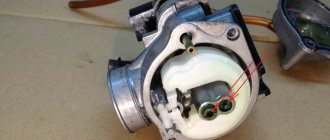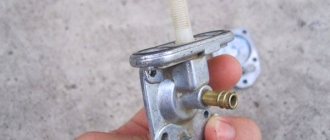Experienced motorcyclists have faced the problem many times: the spark plugs are filled with fuel! This article is intended for those who have encountered such difficulties for the first time. Together we will find out the cause of this unpleasant phenomenon, and also figure out ways to fix the problem and methods to prevent the candles from flooding again.
Typical reasons
First of all, you need to check: the ignition and power systems. Carry out a check in those places that can cause the moped to move. The reasons why the scooter does not start, especially in cold weather, may be the following:
No spark in spark plug
The scooter does not start because there is no spark in the spark plug. In this case, you need to do the following: the spark plug is unscrewed and checked for suitability. Connects to the ignition coil using a wire. Placed on the cylinder. When the crankshaft rotates, the spark at the spark plug is checked. The scooter will not start if there is no spark at the plug, or there is a spark, but it is inconsistent.
Reasons for the lack of spark on the spark plug
Cold weather
The scooter may have difficulty starting in cold weather if there is a problem with the spark plug cap or its connector. In such a situation, the cap is unscrewed from the wire, and the wire is brought 0.3 cm closer to the metal motor element to crank the crankshaft.
A moped can carry current in cold weather. This happens due to the fact that there is contact with the exposed part of the wire and the metal element due to which the scooter starts.
Malfunctions in the power system
A moped may have difficulty starting in cold weather if there is a problem in the power system: lack of fuel or its excess. In this case, you need to check the following elements: gas tank, fuel tap, starting enrichment and fuel pump.
First of all, check the moped's fuel pump
Along with this, it is worth noting that the moped needs to be repaired, and parts should only be disassembled if there is complete confidence that they are faulty. It is best to install only new parts on the scooter, and not used ones, otherwise the engine, when started from the starter, will either work poorly or will not start at all.
Causes of the problem
Even if the engine was able to start, the problem will occur again. If this is not the first time a spark plug on a scooter has been flooded, it’s worth finding and fixing the problem. The culprit could be:
- Dirty air filter. If there is not enough oxygen in the fuel mixture, the gasoline will not burn completely and will remain on the spark plug.
- Mixture quality screw. If the carburetor is not adjusted correctly and the screw is too tight, a similar problem will occur.
- Poor quality fuel. Gasoline diluted with another liquid can also cause this.
- Defect in the ignition system itself. There is no spark, or it is not powerful enough to ignite the mixture.
- Low battery. On days when the temperature drops below zero, you need to make sure that the battery is well charged, otherwise a similar problem will arise.
Flooded candle
Sometimes, if a candle is wet, it is enough to simply dry it. But this will not eliminate the problem and will not prevent this unpleasant situation from occurring in the future. While almost any of the problems described can be dealt with on your own.
Reasons for lack of spark
Often, owners may encounter cases of starting failure in the cold season, although the moped drove well in the autumn. Initially, you need to unscrew the spark plug and carefully inspect for spark, oiliness and color.
Carbon deposits on the electrode
There may be no spark, if the electrode is covered with carbon deposits, then they are cleaned with a metal brush. If there is even the slightest doubt about the serviceability of the spark plug, you should replace it immediately, thereby making your life easier in the future.
Acidification of contacts
If the external signs of the spark plug correspond to suitability, and there is also no spark, then you need to check whether there is a discharge. It is worth noting that you need to be extremely careful, as it can give you an electric shock. If there is no spark and the external signs of the spark plug are normal, then the scooter is checked electronically for acidification of the contacts.
Insufficient fuel
If there is a spark, but the moped still has difficulty starting from the starter in cold weather, you should pay attention to the fuel tank. If it is empty, then it is filled. It is worth noting why old gasoline pours out of the carburetor float chamber. How to do it? There is a bolt at the bottom of the carburetor; it is unscrewed, and after all the fuel has flowed out, it is screwed back in. Before putting the moped in the garage in cold weather, fill the tank full of fuel.
Unscrew the bolt and pour out the old gasoline from the carburetor float chamber
If the above has been checked and done, and the scooter does not start well from the starter, then you can make the following repairs:
- The carburetor is removed and the air filter is cleaned;
- The carburetor is cleaned, the jets and channels are purged;
- Everything is coming back together.
How to restore starting from the starter
The moped does not start well from the starter, however, doing it from the foot is simple and easy. If the engine does not start well from the starter, you must first check the fuse located in the battery compartment.
The location of the fuse on the battery is marked with an arrow.
Due to the often poor quality of the manufacture of the fuses, and, consequently, the entire starter, the wire located inside the starter glass bulb can barely touch the contact caps, which is why the fuse contact becomes unsuitable. After the low-quality fuse has been replaced, the moped can be started using the starter.
How to do your own engine repair
For a scooter engine to function properly, it requires the following components: spark, fuel and compression. The main slogan of a scooter mechanic is that miracles do not happen. Remember that in the process of troubleshooting and repairing a scooter, you can find out whether there is a spark and compression, or why there is no fuel flow. Therefore, if the engine does not start from the starter, then some component is missing or is in a faulty condition.
Many people are familiar with the situation when they are not only too lazy to take their scooter to a workshop, but also don’t want to pay for it all. Then you can repair everything yourself.
Sequence of repair actions
The main rule for detecting malfunctions and repairing a scooter is to step-by-step eliminate the elements of the system when identifying the causes of a breakdown in any of them. Search and repair, especially when starting from the starter, must be done in accordance with a strict sequence, where the chain may act as the beginning, and the end, for example, if there is or is no spark. It is worth noting that you do not need to immediately run for a new switch for the scooter, first make sure that the generator is functioning perfectly, only after that test the wiring if there is no spark, etc.
Checking Basic Systems
It is important to remember that gasoline has the ability to lose its properties if it sits in cold weather and may not even ignite. Also, before making a final diagnosis and starting to repair the moped, if it does not start from the starter, you need to make sure that the spark plug can do its job and the carburetor is functioning normally.
Remember that the scooter starts from the starter when it has an integral part with proper operation of the variator, clutch, camshaft group and valve. To put it simply, if all power systems are in normal condition, then there is a problem in the transmission, thanks to the crankshaft torque, which works closely with the variator.
In the process of diagnosing and repairing a scooter, in some cases it is necessary to do a thorough check of not only individual elements, but also the entire system. For example, if there is debris in the carburetor, provided that it is intact and the air filter is saturated, the presence of dirt in the cavity of the gas tank and the fuel filter is also carefully examined.
Causes of malfunction
Due to a flooded spark plug, the scooter may not start at all or may be unstable. So, what could be the reason:
- Clogged air filter. Insufficient air supplied to the carburetor enriches the fuel mixture. As a result, a large volume of fuel does not have time to burn in the chamber, and the spark plug becomes dirty.
- Incorrect carburetor adjustment. A tightened mixture quality screw on the carburetor has almost the same effect as a clogged air filter.
- Faulty ignition system. There are several faults at this point: faulty spark plugs - bad wires - problems with the ignition coil - incorrect timing (on old equipment, for example).
- Poor quality fuel. Gasoline diluted with another liquid greatly affects the contamination of the spark plug.
Oddly enough, the spark plug on the injector can also flood. This usually happens in winter on worn-out engines. Since the quality of the mixture is regulated by an electronic control unit (ECU), it would seem that the spark plugs should not be flooded.
However, poor compression, a discharged battery, a bad starter, an insufficiently powerful spark and incorrect electrode gaps do not allow the scooter to start at subzero temperatures. In cold weather, the ECU supplies more fuel to the cylinder, since cold air contains more oxygen than hot air.
For a number of reasons described above, the scooter does not start and the spark plug is flooded.
How to understand that the candles are flooded
First of all, you need to define the concept of “drenched candles”, that is, what is it? One of the main operating cycles of a gasoline internal combustion engine is the supply of a fuel-air mixture to the combustion chamber and its subsequent ignition. When, for some reason, the spark plug does not light it, this is called “flooding the spark plugs.”
And all because a large amount of fuel gets into the electrodes and the spark plug body. And the more fuel that gets there, the more difficult it is to ignite it, although in practice this is almost impossible until they are dried.
Most often this happens during the cold season, during significant frosts or simply during cold snaps. As drivers say, “in the cold.” During such a period, there is a heavy load on the battery and if it is weak, then there is always the possibility of flooding the spark plugs. That is, the driver tries to start the car two or three times, while the battery is discharged and the spark plugs are filled with gasoline.
However, spark plugs can be filled with more than just gasoline. two other process fluids can get on it - engine oil and coolant (antifreeze or antifreeze).
Indirect signs that the spark plugs are filled with engine oil are the following situations:
- rapid decrease in oil level in the engine crankcase;
- Unstable engine starting, and at any time of the year;
- decrease in the dynamic characteristics of the car, poor acceleration, drop in power;
- Unstable engine operation at idle speed;
- "triple" of the engine.
It is necessary to understand that the listed signs may indicate other breakdowns in the engine, so it is better to unscrew the spark plug/s from its seat and visually assess the condition of its electrodes and insulator. Moreover, it is advisable to check both for the presence of burnt oil and for the general condition. Much can be understood by color.
Similar signs will indicate that the spark plug is filled with coolant (antifreeze). In this case, there will also be a drop in engine power, a rapid drop in the coolant level, and the appearance of white carbon deposits on the spark plug electrodes and/or its insulator. You may also notice the appearance of white smoke from the exhaust pipe.
We are trying to start the engine
So, we figured out why the spark plug on the scooter floods. The repair methods and starting methods below apply to scooters with 2T and 4T engines.
- The method is suitable if there is no tool. If you flooded the spark plug while trying to start the scooter, then give it time to stand for about 5 minutes. Then turn the gas handle all the way and turn the engine with the starter for about 10 seconds. You can use the foot several times if the starter is faulty. Release the throttle and try to start the engine again - it should work.
- If you have a spark plug wrench, you should unscrew the spark plug and warm it up over a fire, after cleaning it from carbon deposits. With the spark plug removed, you should “blow out” the cylinder by rotating the engine with the starter or foot. Screw in the spark plug and try to start. If unsuccessful, the spark plugs should be replaced.
Advice! Although the first method is faster, it is still recommended to use the second. This cleaning of the ignition system will help avoid such problems for some time.
What to do if the candles are flooded
Measures to eliminate the malfunction directly depend on the reason why the engine is flooding them. Let's look at them in the same order.
When filling with gasoline
The first thing you can do is purge the cylinders for 10 seconds by opening or partially opening the throttles, making the mixture lean. You can also unscrew the spark plugs and clean, burn out (dry), and also check the gap and any other visible damage. It would also be a good idea to have a multimeter on hand to check the voltage at the battery terminals, it may be too low.
Do not attempt to start the engine again until the problem has been repaired. This way the candles will be filled even more.
How to start the engine if the spark plugs are flooded:
- If you fail to start the engine a maximum of the third time, then you need to wait about 5...10 minutes and then repeat the operation.
- Charge the battery or try to “light it” from another car.
- Unscrew the flooded spark plugs and replace them with a spare set. If it is not there, then you need to dry the spark plugs and check the condition of the electrodes, insulator, and metal.
- Try to start the engine with an already charged battery and dry spark plugs.
There is also a method on how to start the engine when the spark plugs are flooded. However, to implement it, you need a well-charged battery . So, when starting, you need to press the accelerator pedal all the way down and at the same time try to start the engine. On cars with a manual transmission, it is also advisable to depress the clutch to facilitate starting.
This is done so that the air that passes through the cylinders dries the spark plugs a little. And accordingly, the more air there is, the better the drying process will occur. On injection engines in this mode, the computer control system turns off the excess fuel supply and the spark plugs dry. As for carburetor engines, in a similar mode they do not create excessive pressure in the cylinders, but, on the contrary, a slight vacuum appears. This physical condition can also dry out the spark plugs a little and “squeeze” gasoline out of them.
If there is gasoline with water, then there are two ways to proceed. The first is to completely drain the low-quality fuel, flush the fuel system and fill in with new, high-quality gasoline. Another option is to use special moisture removers. These products are designed to neutralize the condensate present in gasoline. However, they are able to cope with only a small amount of moisture, so you should not expect a miracle from them.
When the problem is in the sensors or electrics, you won’t be able to start the engine until the faulty element is eliminated. True, whatever the reason, you shouldn’t suffer every morning - you need to look for and eliminate the cause!
When filling candles with oil
As we have already found out, it can be filled with oil both from below and from above. If you have oil in the wells (the insulator has flooded), then the first step is to remove the lubricant. This can be done with a syringe or a paper rag. How the problem itself is eliminated depends on the situation. Either change the gasket or seal it with sealant.
Throws oil at the electrode or candle thread - you can, of course, burn it out on the fire, but this will not solve the problem itself. If there is a strong oil leak into the cylinder you will not get very far; you need to eliminate the cause: change the seals, valve guides, or rebuild the engine and change the rings.
So, if there is a problem with the guides, it is necessary to replace them with a repair option. If this is done repeatedly, then you need to look at the diameter and select it based on the specific situation. If necessary, it is better to seek help from a car service center.
If oil oozes due to wear of the seals, then there are two possible repair options. The first is replacing valve seals. However, this option is only possible if the valve bushings are not very worn. Otherwise, new oil seals will similarly quickly fail. Therefore, the second option is to completely replace the guide bushings.
If there is significant wear on the valve guides, then it is necessary to replace both the valves and the guide bushings.
If piston rings fail, they must be thoroughly diagnosed. The fact is that the valves often fail with the rings, and the inner surface (mirror) of the cylinder is also damaged. If only the rings fail, they need to be replaced. If there are problems with the surface of the cylinders, then you can try to sharpen them. As for the valves, you need to look at their condition. Often they are also replaced with new ones.
If there is a high oil level in the crankcase, then you need to drain it to the MAX mark on the dipstick. However, if the mentioned level has risen due to antifreeze getting into the oil, then a large list of work must be performed. In particular, completely drain the oil, eliminate the cause of the breakdown due to the mixing of lubricating and cooling fluids, flush the cooling and lubrication system, and only then fill in new process fluids into the mentioned systems.
If the crankcase ventilation system is clogged, it is necessary to find and eliminate its cause. The test depends on the design of the system itself. Usually you need to check the pipes, oil separator, PCV valve.
If the intake manifold gasket has failed, then it only needs to be replaced with a new one. Naturally, you need to clean spark plugs and other elements from any motor oil that has gotten on them. A candle, for example, can be cleaned using a sandblaster.
When filling spark plugs with antifreeze
Most often, antifreeze appears in the oil due to the cylinder head gasket burning out or the geometry of the “head” being damaged. In this case, you just need to change the gasket and grind the surface, otherwise the problem will not be solved.
If the geometry of the engine cylinder head has been damaged, you need to contact a car service center for help. There, with the help of special machines (milling, grinding), craftsmen will restore its normal shape, in particular, the lower plane.
If the heat exchanger or its gasket is damaged, in most cases it is necessary to replace these elements, since they are practically irreparable.
In rare cases, not only the head, but also the cylinder block itself can change the geometry. This is a rather complicated case, and you need to seek help from a car service center. There, using special equipment, you can try to restore it. But, unfortunately, this is not always possible. Especially if the engine is old, has a high mileage, or is mechanically deformed, for example, due to an accident.
In older cars, antifreeze can get into the oil, and from there into the spark plugs due to leaking pipes and/or connecting clamps. However, in this case it is impossible to give specific advice, since it depends on the design of the particular car and the condition of its engine (rubber pipes).
However, the spark plugs are filled with antifreeze - this is the least that will happen in case of such a malfunction.
Eliminating the causes of the malfunction
If after performing the manipulations the scooter starts, that’s good, but you shouldn’t relax. Be sure to check for possible faults. What to do to prevent this situation from happening again:
- Clean or replace the air filter. You can make sure that this is the reason by simply trying to start the engine with the filter installed and without it.
Advice! If the condition of your engine is far from new, then cleaning or even replacing the spark plug should be done more often.
- Adjust the quality of the mixture. Set the carburetor mixture quality screw to the optimal position (where the quality screw is located, see this article), clean the carburetor on the moped. If you have a scooter with an injector, monitor the condition of the injectors. Use an injector or carburetor cleaner.
- If you have a 4-stroke engine, pay attention to the valve adjustment. Incorrect release timing can also cause dirty spark plugs.
- The battery should always be well charged and the starter in good working order. After all, candles are often filled in in winter, and in cold weather a reliable battery is required.
- The quality of oil in the frosty season also affects the success of starting a scooter. The oil must be fresh and of the required viscosity for your local temperature.
Advice from experienced motorcyclists! If a spark plug is flooded, you should load the engine at high speeds at least once a week. This ensures that the cylinder and spark plug are purged from accumulated carbon deposits.
Circumstances under which the spark plugs will not fill with gasoline
Of course, these are exemplary conditions, but you can check many of them so that you don’t have to face the morning in a minibus or metro while going about your business.
So, the key criteria are:
- well charged battery and working starter
- high-quality oil with appropriate parameters for the frosty season
- spark plugs and high voltage cable are of high quality and trouble-free
- The injector nozzles were cleaned and adjusted in a timely manner. Preferably not with the help of various additives in the tank, but with the use of equipment for cleaning injectors
- high quality gasoline
People's advice: if you want the engine to start perfectly in cold weather and the spark plugs not to be filled with fuel, the engine must be “twisted” periodically, once a month. Distance 50-100 km at above average speed and on good fuel.
Or once every two days, while moving, give the motor a load at increased speed for 10 seconds so that self-cleaning of carbon deposits and deposits in the chamber occurs.
These conditions are easy to control on your own, without the help of car service professionals.
Experienced vehicle owners know that in the cold season, for some reason, sometimes the scooter does not start. Some people find themselves in such an unpleasant situation in the summer, but much less often. The problem can have many causes, but the most common is a flooded spark plug.
This can happen regardless of the fuel injection system, injector or carburetor, installed on your scooter. The design of the spark plug and methods for troubleshooting the problem do not change significantly.
In the case of an injector, the fuel supply is regulated by an electronic control unit. Cold air has more oxygen. Realizing this, the ECU increases the supply of gasoline. If the spark in the plug is not strong enough, unignited fuel will remain on the spark plug electrodes. Then it will no longer be possible to start an iron horse.
What to do if the scooter does not start? DIY repair
Detailed instructions on what to do if the scooter does not start. Useful information for scooter owners who cannot start it.
One of the most popular two-wheeled vehicles in the world is, of course, the scooter! Many people start with them, since this type of motorcycle is characterized by simple operation and an affordable price. But, as a rule, beginners have no experience in repair and maintenance. In this article we will help you figure out what to do if your scooter does not start. Let's look at standard faults that make the scooter difficult to start. The most important thing in troubleshooting is to learn to recognize it by certain signs and proceed from simple to complex. Sometimes the reason is the most banal - the gas ran out, the battery was discharged, they forgot to turn on the power button or open the gas tap (on a moped). If these conditions are met, but the scooter still doesn’t start, we dig deeper.
A dead battery is a common problem.
If the scooter does not start from the starter, try starting it from the kick starter. The most common problem is that the battery is simply dead due to a long period of inactivity, or has reached its intended service life. But it also happens that the relay regulator fails or the fuse blows. The fuse is usually transparent and its demise can be determined by eye. A malfunction of the regulator relay can be determined by starting the scooter with a kick starter and measuring the voltage at the battery contacts. It should not exceed 14.5 V. To avoid discharging the battery in the future, we advise you to remove the negative terminal, and during winter idle time, keep the battery warm, check the electrolyte level and fully charge it before storage.
If you want to upgrade your scooter, then you will be interested in the article tuning a scooter with your own hands.
Why is there no spark?
The second most common problem is why the scooter won’t start - there is nothing to ignite the fuel, or there is a spark - but there is nothing to ignite. To check the spark, you need to remove the spark plug cap and unscrew the spark plug. It must be dry and clean. The gap between the electrodes is needed 0.6-0.7 mm. The first sign of a lack of spark is that the spark plug is wet and smells of gasoline. This means the fuel did not burn in the cylinder and remained on the spark plug. Dry and clean it, then insert it into the cap and lean it against the cylinder mass.
At the same time, press the starter button for a second or the kick starter a couple of times. The spark between the spark plug electrodes should be clearly visible. If there is no spark, then replace the spark plug with a new one, most often this is the problem.
You may be interested in how to adjust the ignition on Ural motorcycles or install electronic ignition on Izh Jupiter 5 yourself.
The quality of gasoline in Russia is not very good, this quickly kills spark plugs, especially iridium ones. If a spark does not appear with the new spark plug, we look for a fault in the wiring. A broken wire or oxidation connecting the ground between the frame and the engine is a common problem. Another reason could be a burnt-out resistor in the spark plug cap. It can be checked with a multimeter; the resistance should be about 5 kOhm. If this is not the problem, then check the ignition coil, this can also be done with a multimeter. In this case, the resistance of the primary and secondary windings is checked. The resistance of the primary winding, as a rule, tends to zero. Well, the resistance of the secondary should be several kOhms. There shouldn't be a break.
It is also worth checking the switch by replacing it with a known good one.
The next possible malfunction is a break in the wire coming from the ignition switch or the wire coming from the switch. Check the wires for breaks or abrasions. Check the reliability of the female-male plug connections. If no visible damage is found, a wire break can be detected by testing each wire with a multimeter. If the above manipulations did not produce results and a spark never appeared, the last reason for its absence is failure of the generator, pulse sensor or generator windings, which happens extremely rarely. The generator windings can also be checked with a multimeter.
Why does the candles flood?
The reasons for flooding spark plugs depend on what kind of process fluid they are actually filled with. Let's look at them in order.
Fills candles with gasoline
The most common problem is flooding with gasoline. There are most often 3 reasons for this situation.
Low battery charge
If the spark plugs are filled with gasoline “when they’re cold,” then most often a discharged battery is to blame. This can happen in different conditions, both in the warm season and in the cold. However, in winter this happens more often, since in the cold the battery loses some of its capacity and discharges faster.
With each turn of the key, fuel is injected, but when the spark is weak or completely absent, the spark plugs are filled with more and more fuel by such actions. Such a candle is guaranteed not to give a spark until it is dried.
Fuel failure
Carburetor engine
In older carburetor engines, the reason that the engine fills the spark plugs with gasoline may be due to incorrect settings of the carburetor itself. As you know, this unit requires fine tuning, and over time this tuning may get lost. The carburetor simply pours too much fuel into the cylinders, and it does not have time to ignite. In the warm season, with this setting you can still start the engine, but in cold weather this can become a problem.
Injection engine
In injection engines, the ECU (electronic control unit), which operates based on information from several sensors, is responsible for the amount of gasoline supplied. As the temperature drops, it commands more fuel to be supplied through the injectors to enrich the air-fuel mixture. Thus, starting and the amount of fuel supplied completely depends on their serviceability. Responsible for cold starts are the coolant temperature sensor, TPS, IAC and air flow meter.
For cars equipped with an absolute pressure sensor (MAP sensor in English), this sensor is also responsible for the fuel supply, so its failure leads to flooding of the spark plugs when there is a spark. Often, the Check Engine warning light on the panel lights up, and using an error scanner you can read errors P0106, P0107, P0108, P0109.
If the spark plugs are poured while hot, then the reasons may be: bad/faulty spark plugs (breakdown, gap violation), breakdown of explosive wires or other elements of the ignition system.
Fuel with condensate
When temperatures change, condensation (water droplets) forms. Also, water in gasoline can get into the tank and at the gas station. Water naturally does not burn, and gasoline with such an admixture does not ignite well. To avoid such a situation, fuel dehydrators are used in winter and autumn.
Fills candles with oil
Less common, but also more dangerous, is filling the candles with oil. This is caused by more significant breakdowns of individual engine components. Oil can enter the cylinders (on the electrode and threads) either through the rings or through the valves. When the spark plugs are in oil on top, either the sealing rings of the wells are leaking or the valve cover gasket is leaking.
Valve guides
If the working surfaces of the valve guides are significantly worn, their play may occur. Specifically, between the valve stem and the valve guide. Because of this, oil can flow from the cylinder block directly into the combustion chamber onto the spark plugs.
The situation can become more complicated if this is not the first such case when the bushing comes out of the body of the head. Typically, in such situations, a repair sleeve is used instead of a regular one, since it has a larger diameter. But if regular bushings were installed instead of repair bushings, then all this together leads to the consequences described above.
Valve seals
As for valve seals, they can leak oil into the combustion chamber for various reasons. Among them:
- Increasing the rigidity of the crimping part of the seals. For normal removal of oil, they must be relatively soft. Tanning often occurs due to natural aging or frequent overheating of the engine.
- Failure of the crimp spring. It can stretch significantly, become damaged, or simply jump off the oil seal body.
- The oil seal itself has risen significantly from the body of the guide sleeve.
- If the bushing has significant wear, the valve may tilt to one side. Accordingly, on the opposite side, oil can leak from the cylinder block into the combustion chamber.
As a rule, in the situations described, oil gets not only onto the electrode, but is also located at the beginning of the spark plug mounting thread.
Piston rings
Wear of the piston rings automatically leads to oil leakage from the crankcase into the combustion chamber. In addition to simple wear, a situation is possible when the ring (rings) simply burst, which renders it virtually unusable. Or it’s simply stuck, here you can try to decarbonize it. When checking piston rings, it is advisable to check the compression in the engine cylinders.
Clogged oil system ventilation
The VKG system ensures normal oil consumption on a working engine. When it becomes clogged, the pressure of the crankcase gases increases, which leads to the fact that the piston rings will not cope with their tasks, which is why some of the oil will enter the combustion chamber.
Intake manifold gasket
Some cars have their own “childhood diseases” that appear specifically on them. For example, Renault Megane 2 spark plugs may be filled with oil due to a broken intake manifold gasket. However, this can happen on other machines as well.
Oil in spark plug wells
Not all cars have spark plug wells, but for example, on a VAZ-2112 with a 16-valve 1.6-liter engine, on Priors, Focuses, and Chevrolets, spark plug wells filled with oil are a very common occurrence. The reasons why oil may end up in the spark plug well may be as follows:
- poor valve cover seal;
- wear of sealing gaskets of spark plug wells.
The spark plugs are filled with antifreeze
The reasons why the spark plugs are filled with antifreeze are completely similar to the reasons why the antifreeze itself gets into the engine oil. Let's briefly list them:
- Damage (burnout) of the cylinder head gasket. Occurs from aging, mechanical damage or overheating.
- Violation of cylinder head geometry. The popular name is “moved its head.” The situation arises mainly due to significant overheating of the motor.
- Damage to the cylinder block. In particular, cylinder walls, the appearance of microcracks.
Malfunctions in the power system
If there is a spark, but after that the scooter does not start, there is a high probability that fuel is not supplied. To address this issue, start checking at the gas tank. It is advisable if the gas tank is at least half full. To ensure that fuel is supplied to the carburetor, remove the fuel hose from the carburetor by lowering it into a previously prepared container (bottle).
Are all settings normal? But why won't the alpha moped start? See all possible faults!
As a rule, scooters have a built-in vacuum gas valve that opens the fuel supply only during startup or operation of the scooter. To check the valve with the fuel hose lowered into the bottle, we try to start the engine for 3-5 seconds, or until a stream of gasoline appears. In this case, the stream must be constant, at least “as big as a match”. If there is gasoline, but does not flow, the gas valve must be replaced.
If it is working, we look for the cause in the carburetor. First, the air filter must be clean. Because if there is a leak at the junction of the carburetor with the intake pipe, air is sucked in there, the mixture becomes too lean and starting the engine will be impossible. Make sure the gaskets between the carburetor are intact. Let's go further, the reason may be in the carburetor itself.
Start the engine
Just yesterday, the scooter or moped was working normally, but in the morning its engine simply does not start. Probably the reason is a flooded candle. You can, following the instructions, take out and dry the candles, but if you are short on time, you should try the traditional method.
To use it, you first need to let the scooter stand for a little time - about 5 minutes. Then you should completely unscrew the gas handle and turn the starter. Continue for about fifteen seconds. At this time, there will be no fuel supply to the chamber, so it will be purged with air. Most likely, such a simple operation will be enough and the engine will start. This should work on both 2t and 4t scooters.
If the iron horse does not start, you will have to use another method. To implement it, you will need a little time, patience and a spark plug. First, you should unscrew the spark plug and make sure that it is the problem. It can be cleaned with a brush and then dried with a hairdryer. However, any heat source will do: hotplate, oven or gas burner. Next, it is recommended to blow out the cylinder in the same way as with the traditional method. Then insert the candle back. Now the engine just has to start. If this does not happen now, you will have to replace the spark plugs and carry out diagnostics.
After the engine has successfully started, there is a temptation to leave everything as is. However, it is recommended to determine what the problem was. Regardless of whether the spark plug on a moped or scooter is flooded, most likely some parts require cleaning or replacement. But even if the reason is only that the vehicle is not new, there are ways to avoid a flooded spark plug in the future.
Insufficient fuel
Fuel may not flow due to a jammed carburetor shut-off needle. This is possible when it is clogged, or because the level in the float chamber is out of whack. It is necessary to disassemble the carburetor, blow out all channels and jets with compressed air. You can use a bicycle pump for this. After cleaning, check that the float and the rubber seal on the shut-off needle are intact, and adjust the floats. The position of the floats must be horizontal. Otherwise, by bending the tongue under the locking needle, achieve a horizontal position of the floats on the inverted carburetor. After putting it back together, use a transparent hose to accurately check the fuel level. You can use the VAZ washer hose. by connecting it to the carburetor sump and unscrewing the drain screw, the fuel level should be level with the joint of the bottom cover +/- 2mm as in the figure below:
By the way, if the scooter does not start in the cold, in the morning, or in the fall, then the solenoid enrichment valve is most likely faulty.
Probable causes of breakdowns
Now that the power system is in order and the scooter still doesn’t start, let’s look at another possible reason. It sometimes happens that owners often do not service their equipment on time due to ignorance or other reasons. If the above methods do not produce results, the problem may be with the engine. Check the oil level to see if there is any at all. On 2-stroke scooters this is required much more often, but it does not need to be changed, only topped up, since it burns along with gasoline. In any case, whether it is a 2- or 4-stroke scooter, when the oil level is low, the cylinder-piston group suffers sharply. Check the compression by removing the spark plug. This is done with a “compression gauge,” but if you don’t have one at hand, you can use your finger. A working engine should easily squeeze out your finger with air, don’t worry, it’s safe. As for 2-stroke engines, if compression is low or non-existent, the cylinder and piston must be replaced. In the case of a 4-stroke engine, the problem may also be in the valves. Adjust the valves. Lack of clearance or a jammed valve is the reason why the scooter does not start. But a compression leak is possible through a burnt-out valve. This could happen from using too low-quality gasoline. You will have to remove the cylinder head and check the valves for leaks. This is done by pouring kerosene into the inlet and outlet. Kerosene should not leak out for 1-2 minutes. If the tightness is broken, you should dry out the valves and grind them in.
In this article, we looked at typical problems, why a 4t scooter won’t start and the causes of breakdowns. Keep an eye on your scooter, listen to the engine, check the valve clearances, observe oil change intervals, refuel at trusted gas stations, then your moped will last a long time, and you will save yourself from such problems.
Reasons for flooded spark plugs on the carburetor and injector
The main cause of the problem is considered to be incorrect operation of the “electronic brain” of the scooter.
At minus, to start the scooter, more force is required to mix the air-fuel mixture. This is due to the fact that at negative temperatures, a large amount of oxygen requires much more fuel. The “electronic brains” of the scooter see the problem arising and give a command to the injector nozzle to increase the supply of the combustible mixture. It is because of this that a problem arises in the engine compartment of your vehicle, especially if the battery on the scooter is not new. When gasoline is supplied by injectors to the combustion chamber, the starter tries to create sufficient compression in the cylinders and at the same time tries to produce a spark to create a flash. In combination with low-quality gasoline and the previously mentioned process, insufficient compression is created, due to which the scooter cannot be started. Only with perfect compression, which only a new scooter can boast, is it possible to avoid flooding of the injector spark plugs and start the scooter engine even with small impulses.
It is not difficult to guess that at sub-zero temperatures a weak spark is formed, the compression is insufficient, while the injectors supply a large amount of gasoline into the combustion chamber and it is for this reason that the spark plug is flooded with a combustible mixture, as a result of which the scooter does not show signs of life.
